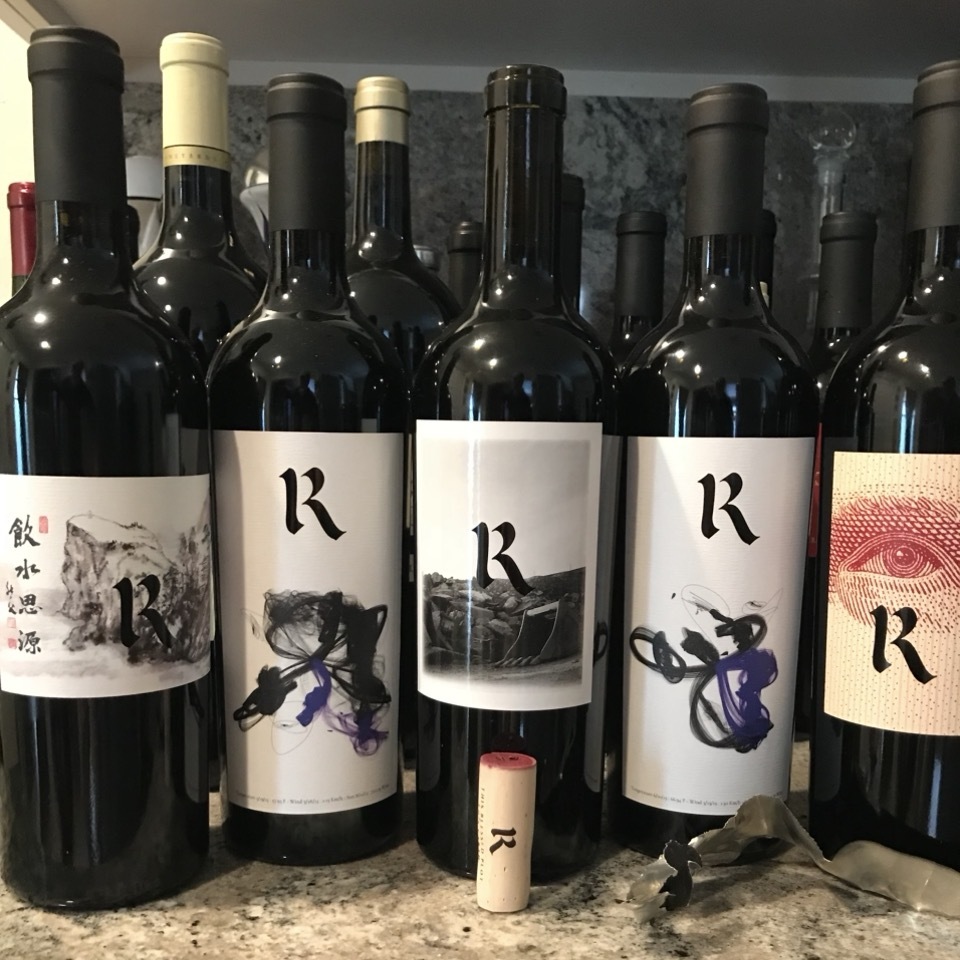Budwood
Château Larcis Ducasse
Saint-Émilion Red Bordeaux Blend 2003
I’m opening my last bottle of the 03 Larcis Ducasse after recently reading a couple of professional write ups about the wines fruit fading and to drink up. I did not find that to be the case w/ my last bottle. I found the wine to be around it’s peak form with another 5 years plus ahead. On the nose; menthol, eucalyptus, ripe; dark cherries, cherries, blackberries, plum, poached & candied strawberries, notes of blue fruits, black raspberries, cherry cola, touch herbaceous; sage & bay leaf, limestone & rich, moist, black, turned earth, crushed dry rocks, graphite, dry soil/clay with dry & fresh dark florals. The body is medium full. Tannins are 75-80% resolved. The length, structure, tension & balance are right where I’d expect them to be and are quite enjoyable. The palate is very similar to the nose. Menthol, eucalyptus, ripe; dark cherries, cherries, blackberries, plum, poached & candied strawberries, notes of blue fruits, black raspberries, cherry cola, touch herbaceous; sage & bay leaf, limestone & rich, moist, black, turned earth, crushed dry rocks, dry & very grippy, edgy minerals, Montecristo cigar, graphite, dry soil/clay with dry & fresh dark florals. The acidity is lovely and the long finish is well balanced with an even tug of war between fruit & earth with the dry earth dominate on the long set. Photos of; of their great southern exposed sunny hillside vineyard, the old craved stone entrance and Nicolas Thienpont & Stephane Derenoncourt. Producer notes & history...Chateau Larcis Ducasse began during the days of the ancient Romans, who valued the best hillside vineyards in the area. The early part of the modern era for Larcis Ducasse begins in 1893, when Henri Raba bought the Saint Emilion vineyard. After Henri Raba passed away in 1925, his wife and son Andre Raba continued managing Larcis Ducasse. His niece, Helene Gratiot Alphandery, inherited the property in 1941. She managed Chateau Larcis Ducasse until 1990. Then her son, Jacques-Olivier Gratiot took control of the property after she passed away and he remains in charge today. Chateau Larcis Ducasse remains the property of the Gratiot Alphandery family today. Prior to 2003, it had been years since the wines of Chateau Larcis Ducasse were prized by Bordeaux wine lovers. The wine had fallen out of favor, due to a lack of attention and effort. That changed in 2002 when they hired Saint Emilion consultants, Nicolas Thienpont and Stephane Derenoncourt to turn things around and manage the estate. One of the first improvements at the property suggested by them was to create a new drainage system. The next step was to change harvesting practices. Prior to 2002, the grapes were often picked too early and over a very short duration of 2 to 3 days. Now, the harvest takes place when the fruit is ripe and picking can take as long as 2 to 3 weeks. Starting with the 2005 vintage, all work in the vineyards moved to 100% organic farming methods. The 10.85 hectare St. Emilion vineyard of Larcis Ducasse is planted to 78% Merlot and 22% Cabernet Franc. This shows a slight change in the vineyard, as more Cabernet Franc has been added to the plantings since 2003. The vineyard is located just around the bend in the road from Chateau Pavie. In fact, their vines but up against each other. They are surrounded by more good producers. To the south, is Chateau Canon La Gaffeliere and La Gaffeliere, and as you move north, Chateau Troplong Mondot and Chateau Pavie. The terroir of Chateau Larcis Ducasse is a mixture of soils. The vines on the top of plateau and the slopes have a south facing exposure. At the higher elevations on the plateau, the terroir is limestone, clay and chalk soils. As you travel further down the slopes towards the terraces, the terroir is a blend of chalky limestone, marl, sand, silt and clay soil. At the base of the slopes, you find sand and clay soils. On average the vines are 35 years of age. While the older plantings were done at a vine density of 6,600 vines per hectare, as the vineyard continues to be slowly replanted, the vine density is increasing with each subsequent replanting. The new plantings are being done at 7,500 vines per hectare. They are also using budwood obtained through selection massale. The yields are kept low at Larcis Ducasse. In 2009, the effective yields were only 25 hectoliters per hectare.To produce the wine of Chateau Larcis Ducasse, the grapes are whole berry fermented. The fruit is transported by gravity flow into traditional, cement tanks for fermentation. Cuvaison takes between 25-28 days. There are no pump overs. Pigeages are conducted during fermentation. Malolactic fermentation takes place in barrel. The wine of Chateau Larcis Ducasse is then aged in 67% new, French oak barrels, which are mixed in size, between standard barrels and 500 liter French, oak casks. The wine is then aged for an average of 18 to 20 months in barrel before bottling. The production averages close to 4,000 cases depending on what the vintage gives. — 8 years ago

Tablas Creek Vineyard
Esprit Blanc de Tablas Roussanne Blend 2022
Tablas Creek is the world's first Regenerative Organic Certified vineyard in addition to Biodynamic Viticulture and the pioneer California Rhone’s movement in Paso Robles AVA, which has a pedigree and collaboration between the Haas family & Perrin’s from Cháteau Beaucastel in Rhône, France by the mid 80’s.
The V.2022 Esprit de Tablas Blanc is their flagship white blend of 33% Roussanne, 32% Grenache Blanc, 14% Picpoul Blanc, 8% Clairette Blanche, 8% Picardan, and 5% Bourboulenc that were chosen from the top lots of 6 white Rhone varieties propagated from budwood cuttings from the Château de Beaucastel estate.
This is an incredibly complex white like no other; mineral-driven, savory, with a nice green sliced apple aromatic notes. On the palate, the mix of lemon and pineapple with some hint of salinity twist your tongue nicely. The overall mouthfeel combining the array of tropical fruits, herbs and the intense long, but not-overpowering finish makes it a top-notch white that differentiate from many produced in the Adelaida District in Paso. A truly winner! — 6 months ago
School House Vineyard
Pinot Noir 2006
Spring mountain Pinot Noir.. DRC budwood... Good people.. Special wine — 11 years ago
Bodegas Paso Robles
Pimenteiro Trousseau Tempranillo
Bastardo, which is this varietal's name in Portugal, is known by 27 different names (the approved name in the USA is Trousseau). This varietal is perhaps one of the rarest red grapes in the country, with only a handful of winemakers producing this wine alone or in a blend. The budwood for these vines came from the El Gavilan Vineyard, planted in the 1890s, and obtained by grower Ron Siletto before the original vineyard was removed and replaced by new root stock and different grapes.
The 2009 Pimenteiro -- which means "pepper pot" in Portuguese -- has a bouquet of white and black pepper with a hint of blueberry. The long finish, full of plum and cherry, also has the distinct flavor of white and black pepper. This unusual wine is perfect for blue cheeses -- perhaps the most difficult food to pair with wine! Serve with any food that likes pepper: rib-eye steak, mushroom soup, butternut squash soup, grilled salmon, lamb, steak, cured paella, stews, and chocolate. — 11 years ago
Scherrer Winery
the Hill Scherrer Vineyard Zinfandel 2016
15% ABV 40 + y/o vines w/ Frank Teldeschi Dry Creek budwood, south facing hillside w/ light fluffy soil. Nicely done again Fred! — 4 years ago
Hartwell Vineyards
T5 Barrel 1 Red Blend 2013
Thats some great juice @Benoit Touquette wine.👍🏼
Winery notes
STORY
Benoit Touquette has continued to serve as winemaker since 2006.
The first vines the family planted were one acre of Bosche clone Cabernet Sauvignon grafted to budwood provided by Dick Grace of Grace Family Vineyards. The first few vintages were also made at Grace Family Vineyards, until the winery on the estate was completed, with Andy Erickson as winemaker. The winery's first release was an estate Cabernet Sauvignon in 1990, which sold out immediately, and with subsequent vintages, Hartwell established a reputation for fine Cabernet Sauvignon.
Over the years, other parcels of the property were planted, allowing the winery to produce other Cabernet Sauvignons, as well as Merlot, a red dessert wine, and a red wine blend. In 2006, the Hartwells purchased a 4.5-acre vineyard in Carneros from which they produce a Bordeaux-inspired Sauvignon Blanc, and brought acclaimed winemaker Benoit Touquette on board to oversee production.
Hartwell Vineyards was founded in 1986 when Bob Hartwell purchased 90 acres of Wappo Hill—the half of Wappo Hill not owned by Robert Mondavi—in the Stags Leap District of Napa Valley.
The fruit for the T5 Cabernet Sauvignon hails from the highest point on the Hartwell estate, blocks 14 and 15, which were planted to Bosche clone 30 years ago. The 100% Cabernet wine ages for two years in T5 barriques, rare and prized barrels from famed French cooperage house, Taransaud. These barrels are toasted and crafted from five-year seasoned staves by coopers who have been awarded the title of “Meilleur Ouvrier de France” (Best Craftsman in France). Much like some of the finest wines, they are available only to a select list of customers due to their limited availability.
Each year, a mere 100 cases of Hartwell T5 are produced, available only by allocation to members of the T5 Cabernet Sauvignon wine club. — 5 years ago









Freddy R. Troya
The V.2022 Esprit de Tablas is the flagship red blend of 40% Mourvèdre, 28% Grenache, 22% Syrah, 4% Vaccarèse, 3% Cinsaut and 3% Counoise selected from the top 6-estate-grown varieties propagated from budwood cuttings from the Château de Beaucastel Estate in Rhône, France.
An absolute crowd-pleaser in all aspects; the nose welcomes aromatic dark red fruits, black forrest, earthy and spices. As for the palate, it is rich and bold, yet fruit-forward slightly juicy with a hint of licorice, minty and lushy. Great acidity and structure with progressive tannins towards the back-end. Loved the texture and some sweet spices by the very end. — 6 months ago